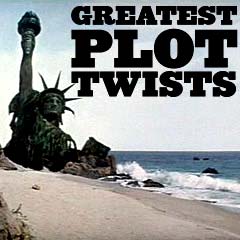
|
Film Spoilers and Surprise Endings P2 |
|
|
||||||||||||||||||||
| Film Title/Year and Plot Twist-Spoiler-Surprise Ending Description | ||||||||||||||||||||
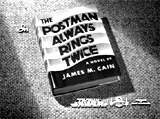
|
The Postman Always Rings Twice (1946)
Director Tay Garnett's film noir was adapted from the 1934 crime novel by James M. Cain. It told about a drifter named Frank Chambers (John Garfield) who was hired to work at a rural California diner called Twin Oaks. He immediately fell in love with elderly owner Nick Smith's (Cecil Kellaway) sexy younger blonde wife Cora (Lana Turner). The femme fatale reciprocrated Frank's interest and they became lovers. Then, the two schemed to kill Nick and make it look like an accident. Their first attempt at murdering Nick was botched, but not the second time. They got him drunk and then arranged to drive along the coast road with him. Frank bludgeoned a wine bottle over Nick's head, killing him. Then, Frank pushed the car off the cliff (with Nick in it), and also injured himself by getting trapped inside the car himself (Frank was subsequently hospitalized). The DA Kyle Sackett (Leon Ames) suspected the two of murder, but only tried Cora for the crime. To neatly wrap up the case, Sackett wanted to pin the murder on Frank - but then on second thought, he shrewdly proposed that Cora was the one responsible for the murder, because Frank was drunk and didn't "know what happened." According to Sackett, Cora's motivation for killing both of them was that "she wanted that sweet little piece of property and that ten thousand dollar insurance money all to herself instead of sharing it with you." The manipulative Sackett goaded Frank into signing a complaint against Cora, destroying any remnant of trust they had for each other. After implicating her in the crime, Frank was assured that he wouldn't be charged as Cora's accomplice in the murder trial. Cora felt double-crossed, and she became enraged at her own lawyer Arthur Keats (Hume Cronyn):
She tried to implicate Frank in the murder - but her anger was never heard by the DA. Without clear-cut evidence against her, Keats was able to have Cora plead 'guilty' to both counts: murder (against Nicholas Smith) and the attempted murder (of Frank Chambers). She accepted a plea bargain - guilty of manslaughter, and received probation (in other words, she was acquitted and freed). Although the two lovers were divided, they began to run the diner together, and it was flourishing. For respectability's sake, Frank and Cora were advised by her lawyer to marry. But soon, Frank was two-timing Cora with another woman, red-headed Madge Gorland (Audrey Totter) with the well-worn line: "With my brains and your looks, we can go places." He spent a week with her in Tijuana, Mexico while Cora was gone. When Frank returned, Cora threatened to denounce him to the DA and be rid of him when she learned of his affair. She knew she couldn't be tried again for the same crime. They both became suspicious and fearful of each other. However, they were finally able to reconcile with each other. The noir's shock ending occurred when the star-crossed lovers were struck by tragedy. Distracted during a 'kisses that come from life, not death' while he was driving, Frank ran off the road, killing Cora in the fatal auto accident. Cora's lifeless arm fell off the seat, and a tube of lipstick slowly dropped to the floor of the car and onto the ground. Frank was charged and convicted with the murder and sentenced to death. The newspaper headlines screamed:
When Frank protested his innocence in killing Cora: ("I didn't do it, I didn't do it...I'm not going to go in the gas chamber for killing her!), the DA informed him that evidence of Frank's complicity in the murder of Cora's husband Nick was discovered, and that being acquitted of Cora's murder would be futile. Frank faced execution, because Cora's farewell note to Frank (written just before she died) had "just enough of a confession to convict you of helping her kill her husband" - according to Sackett. Frank reasoned that he would pay with his life for a crime he didn't commit, making up for getting away with the murder of Cecil. In the ironic ending, Frank had a prayer request - he asked the priest to make things right with Cora so that she would know that her murder was only an innocent accident:
|
   The Two Illicit Lovers: Frank and Cora  Cora on Trial: Two Counts Against Her, Although Plea Bargained  Frank Flirting With Madge 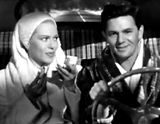 Frank and Cora Reconciled and Driving Home  "Kisses That Come From Life, Not Death" 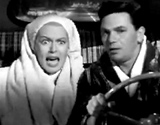 The Car Crash  Cora's Lifeless Arm With Tube of Lipstick in Her Hand   Frank - About to be Executed |
||||||||||||||||||

|
Predator 2 (1990)
This futuristic sci-fi action sequel by director Stephen Hopkins followed the original film Predator (1987), which starred Arnold Schwarzenegger as Major Alan "Dutch" Schaefer, the leader of an elite special forces team fighting an advanced alien life-form. Its tagline described the 'predator':
The setting was Los Angeles in 1997:
The city (a war zone), with violence out of control, was plagued by numerous and bloody drug wars and feuds between Colombian and Jamaican gangs:
In the follow-up film, LAPD Lieutenant cop Michael Harrigan (Danny Glover) had discovered that the scenes of slaughter (skinned corpses, for instance) among the drug cartels were actually the work of the supernatural, ET Predator (Kevin Peter Hall reprising his role), who was equipped with infra-red vision and active camouflage. The sophisticated Predator was set up to enter into a trap in a meat packing-slaughter house plant by the police authorities. In a lengthy battle with the creature, it wounded and then killed Special Agent Peter Keyes (Gary Busey) with a bladed thrown smart-disc. [Keyes was using his position as leader of the task force investigating the cartels to pursue the Predator and capture it for further study.] Harrigan pursued the Predator into an apartment building and then into its own spaceship hidden underground. There, Harrigan killed the brutal Predator by slicing it in the chest with its own bladed throwing smart-disc: "That's right, asshole. S--t happens!" Suddenly and unexpectedly, a group or clan of other predators, an Elder Predator and eight others, materialized out of thin air to confront Harrigan. Outnumbered, Harrigan dropped his glowing green disc weapon and muttered: "OK, who's next?", but these Predators did not attack - they surprisingly let him live. They carried off Harrigan's slain foe, and then the Elder Predator rewarded Harrigan with a trophy prize for killing one of their own ("Take it"). The Elder tossed at Harrigan an antique, flintlock pistol from the 18th century (dated 1715) that had belonged to the famed Barbary pirate Raphael Adolini. [Note: The extra-terrestrial warrior race of Predators had been visiting Earth and hunting humans for sport for generations.] The aliens departed, in spectacular fashion in their spaceship, causing tremendous shaking with debris flying into the air. Garber (Adam Baldwin), a member of Keyes' task force, arrived - and was furiously regretful about not capturing the alien for study, in the final two lines:
|
 LAPD Cop Michael Harrigan (Danny Glover) Battling Predator  The Predator (Kevin Peter Hall)    Harrigan Striking and Killing the Predator in Its Mid-Section With A Glowing Bladed Disc  Harrigan Surrounded by Other Predators   A Trophy Gift to Harrigan: 1715 Flintlock Pistol   Last Exchange Between Harrigan and Garber |
||||||||||||||||||

|
Premonition (2007)
This lukewarm, hyped-up, mysterious and supernatural thriller by German director Mennan Yapo and writer Bill Kelly explained part of its plot with two taglines:
[Note: It was not a remake of Yogen (2004, Jp.) - a Japanese horror film with the English title of "Premonition."] The convoluted, sometimes illogical (with lots of plot holes) and unoriginal trick twist, semi-similar to the hook in Groundhog Day (1993), was that the days of the week were shown out of sequence. The puzzled female protagonist, shocked by the news of her husband's death, became disconnected from linear time during sleep, and was arbitrarily jumping around the scrambled days of the week of his death (before and after he was dead). No wonder she became completely confused and disoriented. The Hanson family (supposedly a perfect marriage) was composed of:
On a Thursday morning, she received a visit from Sheriff Reilly (Marc Macaulay), telling her that her husband had died in a car accident the day before - on Wednesday. But when she woke up the next day - it was now Monday, and he was still alive - she thought she had experienced a nightmare. She was often experiencing other-worldly premonitions (or ESP) of the impending death of her loved one, although ultimately had little control over fate. When she told her lithium-prescribing psychiatrist Dr. Norman Roth (Peter Stormare) that she didn't know what was happening day-by-day, he responded:
At one hour into the film, Linda drew a chart of the days of the week and what she remembered doing each day.
|
 Jim and Linda Hanson (Julian McMahon and Sandra Bullock)   Two Hanson Daughters: Bridgette and Megan  Jim's New Co-Worker Claire Francis (Amber Valletta)  Linda Charting the Days     The Shocking Accident  Pregnancy |
||||||||||||||||||
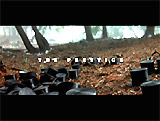
|
The Prestige (2006)
The Christopher Nolan-directed mystery-drama had a very appropriate tagline - referencing dueling stage magicians in Victorian London, Alfred Borden (Christian Bale) and Robert Angier (Hugh Jackman), whose friendship turned into deadly one-upmanship competition, using teleportation devices:
The convoluted, non-linear thriller began with the taunting words "Are you watching closely?" (another of the film's taglines) Part of the reason for some of the uproar over this film's twist was that it had a 'supernatural' explanation that could not have been guessed, and left some viewers feeling cheated. The tale was further complicated by moving back and forth across time periods (and having flashbacks within flashbacks) to lead up to the film's climax. The film's first image under the title screen illustrated the film's major plot point - it was a shot of dozens of black gentlemen's top hats spread across a woodsy area - proving that scientific inventor/wizard Nicola Tesla's (David Bowie) transporter invention (or cloning machine) that first experimented with top hats, was actually duplicating (or cloning) magician Angier each time during his magic trick. The film opened at the end of the 19th century Victorian England, in London. There were two individuals who were both friends and assistants of elderly "Milton the Magician" (Ricky Jay):
Angier was motivated against Borden with deadly revenge when he blamed him for tying a complex Langford Double knot on his wife Julia's wrists when she was serving as an assistant to Milton in a water tank trick. She was tragically drowned during the failed underwater escape trick. Angier and Borden emerged with two separate careers, as two vengeful stage illusionists riskily competing with each other's rival magician acts:
They often caused the other's elaborate tricks to fail when they volunteered from the audience and scandalized the competitor's reputation. Both then developed elaborate disappearing acts known as the "Transported Man" trick. In the trick, the magician entered one cabinet and exited another across the stage, seemingly having been transported across the entire length of the stage in just one second.
In the ending, Angier performed his 'Real Transported Man' trick but seemingly drowned in a water tank (used for another trick) located beneath the stage, when he disappeared and fell through a trap door from above. Borden was accused of the crime of Angier's murder, imprisoned and sentenced to hang (although later it was revealed that he was falsely accused). Just before Borden's execution by hanging on death row, a collector named Lord Caldlow - actually Angier in disguise - appeared at the prison. Before the hanging, Angier/Caldlow persuaded Borden to give up all his secrets, tricks, and devices, in exchange for his adoption of Borden's blonde daughter Jess (Samantha Mahurin) by Sarah (Rebecca Hall), who would otherwise have become a ward of the state. It was then revealed that Angier had remorselessly framed Borden by staging his own drowning murder:
Angier was taking everything away from Borden as he had planned, but things didn't end up well for Angier. As Borden was about to be hanged, he said the words: "Abra - cadabra." After the hanging, Angier returned to the theater, where a stranger entered and shot him. A second 'Borden' had miraculously appeared again and fatally shot Angier. Angier was astonished, asking: "A brother, a twin? You were Fallon, the whole time?" As Angier slowly died, Borden (Alfred actually) explained how he had an illusionary twin 'double' (Fallon) for himself (the one who was executed), so that the transporter trick could be accomplished. The two Fallon brothers were actually identical twins posing as one man without ever breaking the act:
"Alfred Borden" was the name adopted by the twin Fallon brothers, Alfred and Frederick. Each of them took turns being 'Borden' and 'Fallon', each living half of Alfred's life to prepare for their "Transported Man" trick. The difficulty was with the women in their lives - ("We each loved one of them. I loved Sarah, he loved Olivia") - Alfred loved Sarah while Frederick was with Olivia. The surviving twin after the hanging was Alfred! Borden/Alfred claimed he had 'sacrified' a lot of his life for the good of his trick. Borden loved his wife Sarah but his twin Frederick didn’t and Olivia hanged herself. Angier then described how tough his own magic trick was on him, and urged Borden to look around.
Borden/Alfred realized that he was in the underground holding area for the water tanks holding the drowned Angier clones inside of them. Angier gasped to Borden/Alfred that he was totally justified in his expensive and worldwide efforts to create the illusionary trick and create "magic" for audiences, even though it was deadly:
Angier inhaled deeply and then expired, kicking his feet out, toppling a lamp, and setting fire to the theatre. In the film's epilogue, Angier's assistant Cutter again described (in voice-over) the three parts of any magic trick (in shortened form):
Borden/Alfred reappeared in the third part of a magic act ("the prestige") - he reclaimed his daughter Jess that patron Angier/Caldlow had wanted to take away from him. Cutter ended with the words:
|
 Hint: Top Hats in a Woodsy Area  Drowning Death of Borden's Wife Julia  Angier's Drowning  Lord Caldlow (Angier in Disguise)  Fallon Twin  Borden (Twin Frederick Fallon) to be Hanged  The Twins: "We were both Fallon, We were both Borden"  Angier's Cloning Machine  After the Hanging, Alfred Borden = Surviving Twin Alfred Fallon  Angier's Dying Words to Borden/Alfred: About Magic  Borden/Alfred Reclaiming His Daughter Jess |
||||||||||||||||||

|
Presumed Innocent (1990)
Director Alan J. Pakula's legal drama was about a prosecutor who was charged with the murder of his female colleague and mistress. Its tagline was: "Some People Would Kill For Love." The main characters involved in the story were:
When Carolyn, Rusty Sabich's assistant, was found raped and murdered, Rusty was assigned to handle the investigation. He found himself trapped in a 'conflict of interest' case to look into his own ex-lover's murder, because he had engaged in a clandestine affair with Carolyn (that began with sex with her on his office desk). During the investigation into the case, semen found in the victim's body contained only dead sperm, and the killer's blood was Type A (matching Rusty's). Rusty's fingerprints (on a beer glass) and Sabich rug fibers were found in Carolyn's apartment - and Rusty's affair with Carolyn was ultimately uncovered. Rusty was charged with the murder and put on trial. However, with the fact that Carolyn was unable to conceive (due to a tubal ligation operation), it was unusual why she would have used a spermicidal contraceptive. It appeared that the fluid sample from her body had been planted. As a result of missing and contradictory evidence, and a lack of motive, Rusty was acquitted. In the film's final minutes, wife Barbara delivered a shocking revelation to her husband. Barbara confessed that she had killed his assistant Carolyn Polhemus due to jealousy regarding their secret adulterous affair. Barbara admitted her guilt to her husband when he discovered one of his claw hammers (the murder weapon) covered in dried blood and blonde hair and asked her about it. She gave a lengthy rationale:
She described how she had committed the murder and made it look like a rape by a "sex-crazed man." Rusty's voice-over ended the film, in which he took full blame:
|
 Rusty Sabich (Harrison Ford) Cheating With Carolyn Polhemus (Greta Scacchi)   Barbara's Confession of Murder to Her Stunned Husband Rusty |
||||||||||||||||||

|
Primal Fear (1996)
Director Gregory Hoblit's neo-noirish legal-courtroom thriller was based upon William Diehl's 1993 novel. In the story, a defense attorney vigorously defended a client that he believed was not guilty (due to multiple personality insanity) - with unexpected consequences. Its tagline provided some clues:
The main characters were:
Vail was hired (pro bono) to defend Aaron who was accused of viciously murdering Chicago's influential Archbishop Richard Rushman (Stanley Anderson) in his residence. The Archbishop was later revealed to be involved in sexual abuse and corruption. Early on, Vail witnessed how Aaron Stampler suffered from multiple personality disorder with two distinct personas or personalities, due to his suffering abuse at the hands of his father - and continuing abuse by the Archbishop:
During one intense cross-examination in the seemingly impossible case, the violent 'Roy' erupted from Aaron's personality and attacked the Assistant District Attorney prosecutor Janet Venable (Laura Linney), Vail's ex-girlfriend, during the trial. Eventually, Vail was able to clear his client on the grounds of insanity. The shocking twist of the film was revealed after the trial's conclusion. As Aaron congratulated his lawyer in his cell, he apologized with a stutter for injuring Venable's neck ("Will you t-tell Miss Venable I'm sorry? Tell her I hope her neck is OK"). It suddenly dawned on Vail that Aaron was uncharacteristically remembering what Roy had done, rather than blacking out. Aaron had unwittingly revealed that he was only pretending to be insane and had actually premeditatively murdered two people:
Also, he admitted that Roy was his real personality (and in charge) and that "there never was an Aaron either, counselor." As Marty left the cell and courtroom, disgraced, devastated and disgusted, he heard 'Roy's' closing words:
|
 Aaron Stampler (Edward Norton)  Aaron's Defense Lawyer Marty Vail (Richard Gere)  The Real Personality: "Evil Roy"  Marty Leaving Courtroom |
||||||||||||||||||

|
Primer (2004)
The non-linear film, a complex, low-budget science-fiction tale by writer/director/producer Shane Carruth, was almost impossible to interpret after a single viewing. It was often interrupted by jump-cuts and various unidentified duplicate (and triplicate) reiterations of the main protagonists. Dialogue in the contrived film was very off-putting - almost entirely composed of overlapping, terse techno-babble. It was a morality tale of sorts, reflected in its tagline:
Its two main characters were:
The brain-twisting film was partially (and unreliably) narrated (in voice-over) by an Aaron character, who had originally (as the film opened) established a project-work area in his suburban Dallas, Texas garage, to build a revolutionary invention that could be marketed for venture-capital funding. Although there were four engineers (all white-collar guys wearing ties and long-sleeved shirts, day and night) collaborating together to begin, only two emerged as the main characters. As the result of an experimental accident, the two realized they had stumbled upon a time-travel device - i.e., the ability to travel backwards in time (not forwards), but only as far back in time as the time machine existed. They had built a large coffin-sized "box" that was housed in a locked U-Haul storage facility, where they would go on increasingly longer 'trips' - by remaining in the box. A six-hour stint in the box would reverse time and put the box's occupant 12 hours earlier. Each time the box was utilized, a double was spawned (from a distance, they watched their own doubles in amazement), and it often meant living each day twice (sometimes with 36 hour days). At first as they experimented, they would drive their present selves to Russellfield (Texas) to hide out in a hotel room, to avoid causitive activity, media input (by unplugging everything) or other disjunctions. Their first thoughts were to abusively exploit their knowledge - by manipulating the stock market or possibly betting on March Madness games. But then they began to notice numerous problems and repercussions as a result of their new invention:
Trust between the two started to erode, fracture and break, when a second "failsafe" machine was built by Abe in secret. It would allow him to go back and nullify any potentially negative consequences that had happened, back to the time of the invention's conception. Things further intensified with the thought of taking one time machine inside another time machine. Both tried to second-guess, re-engineer, or sabotage each other's efforts, by gaining control of each other's "failsafe" machines. Irresponsibly, the two also tried to change events that they knew would happen - they reorchestrated or reverse-engineered a potential shooting at a party. Aaron was confident that their plan would work, boasting that they were in full control: "We're prescient." However, they fretted about how many trials and iterations it would take to get it "perfect," while at the same time rationalizing their gross manipulations of time:
Aaron was made a hero when he saved Rachel from being shot by her ex-boyfriend. It became clear that time-traveling Aaron (wearing an earpiece toward the end of the film) was listening to recorded dialogue of the day's happenings, following along (as with a "primer") so that he could engineer everything the way he wanted and become the 'primary' controller. The film ended with versions of Aaron and Abe arguing with each other at an airport. Abe warned Aaron to never return. Aaron (or his double) was seen in a foreign, French-speaking country making plans (in a large airplane hangar?) with workers to build a much larger "box" for group time-travel. In voice-over, he spoke the film's final words of caution:
|
    Aaron and Abe  The Time-Travel Box 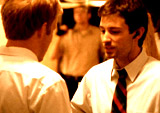 
|
||||||||||||||||||

|
The Professionals (1966)
Director Richard Brooks' western was based upon Frank O'Rourke's novel, A Mule for the Marquesa. A four-man mercenary team (the film's tagline: "Rough, tough and ready") was hired to complete a task by a Texas railroad tycoon/millionaire Joe W. Grant (Ralph Bellamy), in the year 1916 (at the end of the Mexican Revolution). Grant wanted the "professionals" to rescue his beautiful wife Maria (Claudia Cardinale), who had been abducted by Mexican revolutionaries led by the guerrilla leader Captain Jesus Raza (Jack Palance). A reward was offered: $10,000 for each man ($1,000 was paid upfront).
By the film's conclusion, they had completed their job of rescuing the kidnapped wife Maria from Raza's bandit camp, and delivered her to Grant just across the US border. They had also captured the wounded bandit leader. The plot's twist was that a major character reversal was now fully revealed - Maria actually loved the Mexican outlaw. She was his willing mistress. Grant had "bought" Maria for an arranged marriage, but she had willingly escaped and returned to be with Raza in Mexico. Grant was the real 'kidnapper' - not Raza. When Maria was reunited with Raza, she hugged him. Dolworth confessed to Rico after returning with the wounded Raza: "I found out what makes a woman worth $100,000," but agreed she shouldn't be turned loose.
When they brought Maria to Grant to get paid for their services just across the US border, he didn't want the "professionals" to notice his interactions with 'Mrs. Grant' - and he stated: "I hereby declare our contract satisfactorily concluded" and wanted them to hurry off to town for a bath. And then they watched as Grant ordered Raza killed, but the professionals wouldn't allow it, led by Dolworth: "You haven't earned the right to kill him" It was obvious that Maria didn't want to be with Grant, and threatened: "I will run away again." When Grant insisted: "You're my wife, you belong to me," she asserted that she belonged with Raza! ("I belong here...with him"). Grant abused Maria, grabbed her and slapped her across the face - and demanded that she return home with him. The professionals decided to abandon their "bad deal" mission as Rico explained to their employer: "Gentlemen, you heard our employer. The lady's going home. (to Maria) You don't think that J.W. Grant was stupid enough to pay that ransom, do ya?...(to Grant) There was no kidnapping! Right, Mr. Grant? Is that right, Mr. Grant?" Grant disagreed: "That is none of your business." Rico told the real kidnapper, Grant, that his wife would be going home with Raza: "Wrong, Mr. Grant. We made a contract to save a lady from a nasty old kidnapper - who turns out to be you." They allowed Maria to ride off with the wounded Raza (in the back of a buckboard), to return to Mexico. In the film's curtain closing:
|
 Rescued "Kidnapped" Maria (Claudia Cardinale) Hugging Jesus Raza (Jack Palance)  Dolworth (to Rico): "Turn her loose?"  Maria With Wounded Raza  Rico Assisting Maria to Return Home with Raza  Dolworth: "We both made a bad deal, Mr. Grant. You lose a wife and we lose $10,000 dollars apiece." 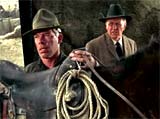 Rico: "Yes, Sir. In my case an accident of birth. But you, Sir, you're a self-made man." |
||||||||||||||||||

|
Prometheus (2012)
Director Ridley Scott's science-fiction film was a long-awaited prequel to the series of Alien films, including Scott's own first film in the franchise in 1979. The prologue was of a lone, muscle-bound, humanoid, pale-white alien (Engineer) at the top of a gigantic waterfall. The Engineer/alien sighted a large spaceship disc hovering above him and about to depart, then disrobed his cloak. The extra-terrestrial creature ceremonially and ritualistically drank a viscuous black goo-liquid from an opened urn, which caused the alien to retch, grunt and contort. An interior molecular transformation occurred before the alien died, then fell and disintegrated or dissolved in the waterfall. [Later revealed, the gardener-alien, a life-giver, was apparently creating life on primordial Earth - self-sacrificially seeding Earth with his own DNA.] The film opened in the year 2089 in the late 21st century. Prehistoric cave paintings, about 35,000 years old, were discovered on the Isle of Skye in Scotland. The cave paintings depicted various figures, including a tall human figure pointing to a pattern or constellation of stars (star-diagrams were showing the way for humans to locate their Engineers). The Scottish pictogram was the "same configuration" as those in many other different and separated cultures showing men worshipping giant beings pointing to the stars. The two archaeologists making the important findings were:
Shaw noted: "I think they want us to come and find them." Four years later in the year of 2093, the Weyland Corporation (with the logo "Building Better Worlds") sent a monstrous, advanced space vehicle named Prometheus (with holographic displays) and a crew of 17 on a deep-space mission to a destination undisclosed. It was presumably following the recently-discovered star map, to seek the origins of humanity. Before waking from cryosleep after 2 years, 4 months, 18 days, 36 hours and 15 minutes, the spaceship's crew was monitored by the ship's robotic android David (Michael Fassbender), who amused himself by walking around the ship, riding a BMX bicycle, bouncing a basketball and making impossible hoop shots, taking language lessons, watching Lawrence of Arabia and imitating Peter O'Toole's hairstyle. The expedition was led by Dr. Shaw and Dr. Holloway, and funded with a trillion dollars by the Weyland Corporation. During a briefing conducted by Weyland's bitchy, autocratic executive Meredith Vickers (Charlize Theron), the group watched a hologram of a very elderly Peter Weyland (Guy Pearce) delivering a recorded message he had made in the year 2091:
The group was informed that the cave paintings from many cultures had directed (or invited) their way to a star system far beyond Earth, where they were now about to land on the planet's sole, life-sustaining moon (LV-223) in order to explore its ruins. It was believed that the directional signs to the planet and its moon in the cave paintings had been left by alien "Engineers" - those who designed, engineered or created humanity on Earth. The planet where they were landing was where the Engineers had come from. After landing and suiting up, they entered a large hollow, domed rock structure which they mapped with robotic 'pups,' and discovered it had breathable air and water - evidence of terraforming. David accidentally triggered a projected recording - images of humanoid aliens running at them, and they found the body of one large alien Engineer (similar to the "Space Jockey" in Alien), decapitated by a doorway with its helmeted head on the other side. It had been dead for 2,000 years. David saw large metal vases contained contaminating (DNA-destroying) black slime with squirming snake-like creatures, and put one into his pack. Two of the crew's fearful scientists (including Millburn (Rafe Spall) and geologist Fifield (Sean Harris)) decided to return to the ship after the latter told Shaw: "Congratulations on meeting your maker." However, they became stranded in the cave-like structure, as the rest of the group returned to the ship. Upon investigation of the retrieved alien head-skull, they realized it was actually a helmet which they pried off to reveal the head underneath. An experiment to revive it led to its implosion, as David commented: "Mortal after all." They conjectured that it belonged to the body of one of the alien Engineers (with pale skin like the humanoid in the film's opening), with sample DNA that matched human DNA ("Their genetic material predates ours. We come from them"). Shaw exclaimed: "It's us. It's everything. What killed them?" Had their mission to 'meet their maker' and get answers (such as "Why they even made us in the first place") been a failure? The first of many twists was revealed:
David caused Dr. Holloway to become infected and seriously ill by dunking some of the slime from the vase into the archaeologist's drink. Meanwhile, snake creatures emerged from the vases, attacked both of the stranded scientists in the cave (Millburn's body were found there during a second trip). Examining further in a control room during the return trip, David saw a hologram of the Engineers plotting courses through the stars and different planets, one of them being Earth. He also found a hypersleep chamber with pods, one of which contained the last-remaining, still-alive Engineer. Soon after, Dr. Holloway self-sacrificially asked to be exterminated by Vickers' flamethrower in order to stem the infection of the others, although he had already infected Dr. Shaw by having sex with her. It was suggested by David to Dr. Shaw, with an accelerated three-months pregnancy, that she be put in cryostasis and returned to Earth (Weyland's evil plan was to bring the monster home!). She wanted the growing embryo out of her body. She conducted a self-inflicted caesarean-abortion in an automated, robotic surgery med-pod machine. She delivered a nasty-looking, coiled-up, octopus-like creature that she was able to gas in the chamber after she was sewed up. Meanwhile, a contaminated Fifield, one of the stranded geologists from earlier, attempted to gain access to the ship, and was eventually prevented from entering by another flamethrower. Dr. Shaw explained how wrong they were about the alien Engineers:
The Engineers were actually making bio-weapons of mass destruction on the far-away moon. Engineers were warriors - not creators, in the process of venturing to Earth to destroy it with their monstrous creations, before they were stopped by their own escaped black goo in the vases. Unbelievably, Dr. Shaw was still curious, however, about what the last remaining Engineer had to say - an answer to why the Engineers had targeted Earth. Weyland was awakened, then transported by David (with Dr. Shaw) into the rock structure, assured of the belief that the Engineer would save him from death. Another twist was revealed:
Weyland's group entered the bridge's control room where David had earlier located the sole surviving Engineer ("a superior species"). David bluntly explained why the Engineers were planning a trip to Earth: "Sometimes to create, one must first destroy." Dr. Shaw screamed out questions, including why the Engineers hated Earthlings so much.
During the resultant, catastrophic finale:
The film ended in the year 2094, as she continued onward - but not to Earth ("I don't want to go back to where we came from. I want to go where they came from"). She was on a determined search for the alien homeland planet in one of the alien's other ships, to find out why they wanted to destroy humankind ("They created us. Then they tried to kill us. They changed their minds. I deserve to know why"):
In the conclusion, inside the remains of the lifeboat, was the appearance of an embryonic version of the Xenomorph Alien from the exploding chest of the dead Engineer. After the final credits was this logo: WEYLAND CORP BUILDING BETTER WORLDS SINCE 10. 11. 12 weylandindustries.com/timeline |
  Prologue  Pictogram  Dr. Elizabeth Shaw (Noomi Rapace)  Meredith Vickers (Charlize Theron)  Android David (Michael Fassbender)   Helmet and Alien Engineer Head  Snake Creature  Dr. Shaw's Caesarean Birth of Squid  The Engineer  David's Decapitation  Death of Engineer by Shaw's Alien Offspring   Birth of Xenomorph Alien |
||||||||||||||||||

|
Hitchcock's suspense thriller was adapted from Robert Bloch's 1959 novel of the same name. In 1960, the horror film was controversial for its shocking levels of violence, sexuality, and deviant behavior. The tale included such taboo topics such as transvestism, voyeurism, stabbing as rape, implied incest, and hints of necrophilia. It began by following the misguided path of the presumed heroine:
She had become frustrated by the delay in marital plans with handsome boyfriend Sam Loomis (John Gavin) from Fairvale, Arizona, whom she had met for sex during her lunch hour. Impulsively, she stole $40,000 (a down-payment from a client of the real estate company) where she worked, after she was asked to deposit the funds. Her motivation was to pay off Sam's debts to clear the way for their marriage. During her flight in her car to Fairvale to give Sam the money, and in the midst of a torrential rainstorm, she pulled off the road and came upon the Bates Motel, where she met (and had a small bite to eat in the motel's back parlor) with:
Norman described for Marion his relationship with his mentally-ill, possessive Mother, who lived with him in the gothic house on the hill behind the motel. After settling into Room 1 of the motel, Marion had a change of heart and decided to rectify her crime by returning the funds. However, after being spied upon by Norman through a peephole, about 48 minutes into the film, Marion was unexpectedly and terrifyingly murdered, as she began to take a shower. To cleanse herself, she had stepped into the water-stream and was brutally stabbed by a silhouetted, female figure brandishing a long knife. To his horror, Norman discovered the murder and meticulously cleaned up any evidence of the blood and her possessions, by dumping everything in the trunk of Marion's car, and sinking it in a nearby swamp. Soon after, a private detective named Milton Arbogast (Martin Balsam) was snooping around for answers at the Motel, after speaking to a nervous and suspicious Norman, and desiring to speak to Norman's mother (who was seen in shadowy form in the home's upstairs window). The PI was brutally murdered by the same knife-wielding female figure as he climbed the stairs of Norman's house. Soon after Arbogast's disappearance, Sam and Marion's worried sister Lila (Vera Miles) spoke to Fairvale's Sheriff Chambers (John McIntire) who told them the history of Norman and his mother:
In the famous shocking finale, it was revealed that Norman was keeping the mummified corpse of his "Mother" in his basement fruit cellar. Sam and Lila registered at the hotel as husband and wife, and then went searching for clues. When Lila discovered the Mother in a rocking chair in the basement, she was attacked from behind with a knife by transvestite Norman (wearing his Mother's dress and a wig) - and was saved only at the last minute by Sam's intervention. In the expository conclusion, police psychiatrist Dr. Richmond (Simon Oakland) told how Norman was actually the murderous "Mother" who dressed in his mother's clothes. He explained how a "disturbed" Norman had an incestuously possessive and jealous love for his mother, so he poisoned both her and her lover after he discovered them in bed together ten years earlier. To wipe clean and obliterate the unbearable, intolerable crime of matricide from his conscience and consciousness, a remorseful, devoted and loyal Norman developed a split personality. He also dug up and stole his Mother's body, and used his taxidermist skills to preserve and stuff her corpse (she was revealed as a dessicated skeleton kept in hiding in the basement), to keep her 'alive.' Then, he would ease his loneliness by lying with her in bed ("A boy's best friend is his mother..."). When attracted to Marion, Norman was completely transformed into his Mother and became jealously and pathologically mad -- his "Mother" side, which was escalated to full reality, stabbed Marion to death. In the concluding scene, Norman's two personalities fused and he had become his dominant Mother's final victim. Completely still, he stared into space within his box-like jail cell, wrapped and insulated from the world and huddled in a blanket. A grinning smile slowly crept over his face, subliminally superimposed by and dissolving into the grinning skull of his mother's mummified corpse, as his voice-over intoned:
The last image was the dredging of the swamp - Marion's car with her body and the almost-$40,000 in the trunk was hauled trunk-first from the muck by a heavy clanking chain on a winch. |
 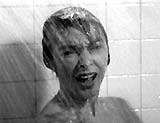 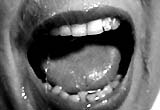   Marion Crane's (Janet Leigh) Shower Stabbing  PI Arbogast (Martin Balsam) Stabbing  Lila (Vera Miles) Looking for "Mother"  Norman's Mummified Mother   Sam (John Gavin) Struggling With "Mother"/Norman to Save Lila  Dr. Richmond (Simon Oakland) 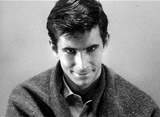 Insane Norman Bates (Anthony Perkins)  Marion's Dredged Car in Swamp |
||||||||||||||||||

|
A Pure Formality (1994, It./Fr.) (aka Una Pura Formalità or Une Pure Formalite)
Italian director Giuseppe Tornatore's compelling psycho-drama starred basically two characters who were engaged in a tense battle of wills, during the questioning of a murder suspect on a stormy night in the French countryside. The trailer's narration and poster nearly gave away the film's plot twist:
The film dramatically opened with the large close-up of the end of a gun barrel rotating into view - and firing at the camera! Under the credits, a man was running through the woods near his home, out-of-breath and in mad flight (filmed with a Steadi-cam from his POV). There had just been a mysterious gunshot-killing of an unnamed and unidentified victim in the same vicinity. Was he the suspected killer? Was there really a crime? The individual was picked up and taken to a dank police station (without power or telephone service) with a leaking roof - for cross-examination questioning by the local police inspector. The two main characters were:
Confusing flashbacks, disconnected images in fast-paced montage, and other inconsistences in the suspect's ever-changing story were revealed during the questioner's attempts to learn the truth. Often disoriented and revealing a troubled past, Blaise/Onoff repeated himself, then claimed amnesiac memory loss, and often seemed to incriminate himself. There were attempts to confirm the man's claim that he was a celebrated yet reclusive novelist/playwright named Onoff. The Inspector was familiar with Onoff's literary works, adding another layer of complexity (Was Blaise who he said he was?). Toward the end of the film, Blaise/Onoff revealed his 'diary' bag of photographs from his life. The ambiguous, existentialist, Twilight Zone-like ending was similar in its ending to An Occurrence at Owl Creek Bridge (1962), Jacob's Ladder (1990), A Pure Formality (1994), The Sixth Sense (1999), The Others (2001), Dead End (2003), Stay (2005) and Passengers (2008). It was strongly hinted that the suspect was experiencing an after-life nightmare - trying to forget that he had committed suicide. The murdered victim was indeed himself (he had shot himself in the forehead), and he was poised between death and the after-life. |
 Gun Barrel Blast!    Murder(ed) Suspect Onoff (Gerard Depardieu)  The Inspector (Roman Polanski)    The Suicide
The Suicide |
||||||||||||||||||